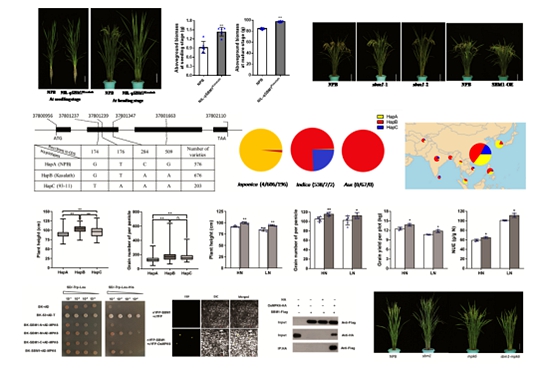The SEEDLING BIOMASS 1 Allele from Indica Rice Enhances Yield Performance under Low-nitrogen Environments
Rice grain yield has risen sharply since last century thanks to breeding for dwarfness and heterosis utilization. However, continual decrease in cropping area along with excessive use of fertilizers has led to high resource consumption and environment pollution, posing a threat to yield performance. With the increasing demand to further increase yield potential, identification of genes determining both high yield and high nitrogen utilization efficiency crucially contributes to breeding super rice varieties through molecular design.
The Functional Genomics Group from China National Rice Research Institute (CNRRI) of the Chinese Academy of Agricultural Sciences (CAAS), in collaboration with researchers from Agricultural Genomics Institute at Shenzhen (AGIS) of CAAS, identified SBM1 as a major gene enhancing nitrogen utilization improves yield performance.
In this study, researchers aimed at a primary-mapping QTL controlling rice seedling biomass on chromosome 1 (qSBM1) detected in the recombinant inbred lines derived from a cross between 93-11 and PA64S and cloned the underlying gene (LOC_Os01g65120) by using near-isogenic lines (NILs) containing Kasalath allele at qSBM1 (NIL-qSBM1Kasalath) in the Nipponbare (NPB) background as well as a series of transgenic lines.
Based on map-based cloning and functional verification, SBM1 was shown to significantly affect many yield-related traits including height, grain number per panicle and seedling biomass. Three main haplotypes of SBM1 were distributed differently in rice subgroups of japonica and indica rice. Through phenotyping, rice accessions with Kasalath haplotype (HapB) at SBM1 tended to have a higher grain yield ratio (LN/HN), indicating this haplotype has great potential for improving nitrogen utilization in rice, as shown by desirable yield performance under low-nitrogen conditions. The function of SBM1 and OsMPK6 on biomass and grain number per panicle was confirmed while interaction between the two was identified. The work provides a new clue to breeding eco-friendly rice with high yield potential and nitrogen utilization efficiency.
The study entitled “The SEEDLING BIOMASS 1 allele from indica rice enhances yield performance under low-nitrogen environments” has been recently published in Plant Biotechnology Journal. Postdoctoral Researcher Xu Jing and Ph.D. Candidate Wang Jiajia from CNRRI, Associate Investigator Shang Lianguang from AGIS, are the co-first authors. Professor Qian Qian and Professor Zhang Guangheng from CNRRI are the co-corresponding authors.
This research was supported by grants from the National Natural Science Foundation of China (31861143006, 31901483 and 31770195), the National Key Research and Development Program (2016YFD0101801) and Zhejiang Provincial ‘Ten Thousand Talent Program’ Project (2018R52025, 2019R52031).
Paper link: https://onlinelibrary.wiley.com/doi/10.1111/pbi.13642

By Shen Huizhi (shenhuizhi@caas.cn)
-
 Apr 18, 2024Opening Ceremony of the Training Workshop on Wheat Head Scab Resistance Breeding and Pest Control in Africa Held in CAAS
Apr 18, 2024Opening Ceremony of the Training Workshop on Wheat Head Scab Resistance Breeding and Pest Control in Africa Held in CAAS -
 Apr 03, 2024IPPCAAS Co-organized the Training Workshop on Management and Application of Biopesticides in Nepal
Apr 03, 2024IPPCAAS Co-organized the Training Workshop on Management and Application of Biopesticides in Nepal -
 Mar 28, 2024Delegation from the School of Agriculture and Food Science of University College Dublin, Ireland Visit to IAS, CAAS
Mar 28, 2024Delegation from the School of Agriculture and Food Science of University College Dublin, Ireland Visit to IAS, CAAS -
 Mar 25, 2024Director of World Food Prize Foundation visited GSCAAS
Mar 25, 2024Director of World Food Prize Foundation visited GSCAAS -
 Mar 20, 2024Institute of Crop Sciences (ICS) and Syngenta Group Global Seeds Advance Collaborative Research in the Seed Industry
Mar 20, 2024Institute of Crop Sciences (ICS) and Syngenta Group Global Seeds Advance Collaborative Research in the Seed Industry
